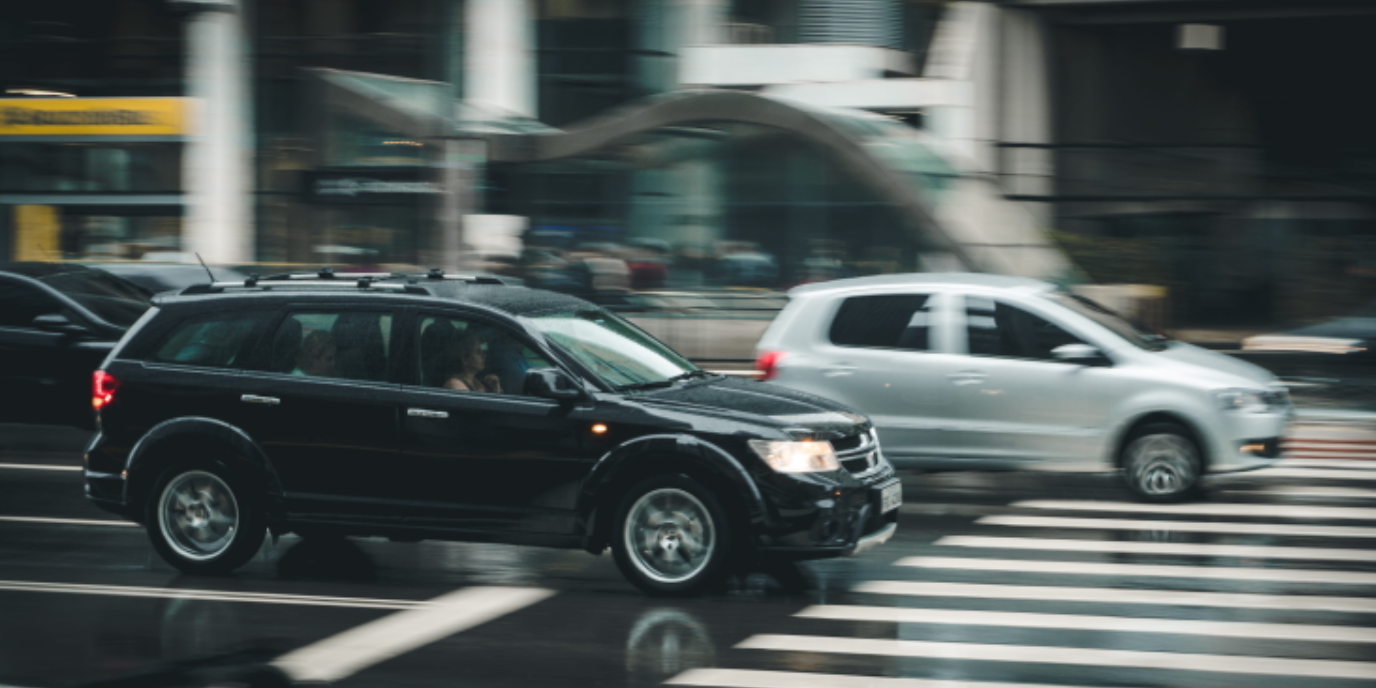We've known for years that the drivers of massive trucks, SUVs, pick-ups and vans are more likely to kill pedestrians, cyclists, and motorists in smaller vehicles, so how can we keep the average American automobile from getting any bigger before anyone else dies?
That's the subject of a new report from the Road to Zero Coalition, which has put together what the group thinks is the first aggregation of academic and available research on why the phenomenon of car bloat is so bad – and what we can do about it.
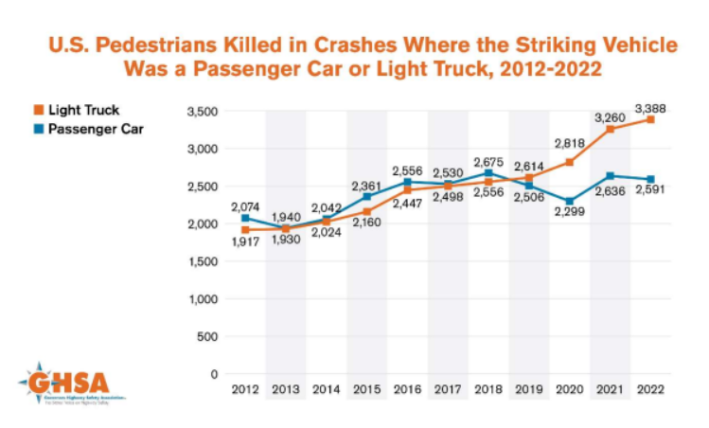
In the last few decades, so-called "light trucks" have all but claimed the U.S. vehicle market, accounting for 75 percent of vehicles produced today, up from just 20 percent in 1975. And those vehicle models themselves have gotten larger, too, driving up the size of the average American car by eight inches in height, ten inches and length, and a stunning 1,000 pounds in weight over the last 30 years — especially as drivers fight to be the last road user standing in the deadly "SUV arms race."
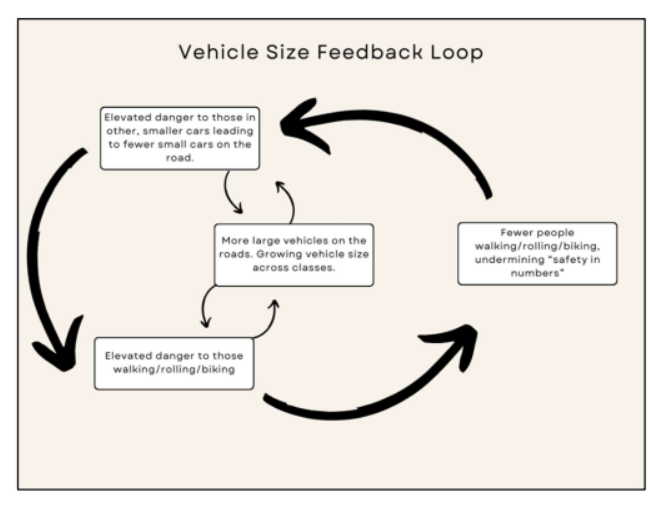
Experts say there's little doubt that extra steel has helped drive the pedestrian death crisis to new heights. But the question of why, exactly, big vehicles are so much deadlier than sedans has been the subject of a mountain of research that Streetsblog has been meticulously tracking for years — and even now, we still don't have all the answers we seek.
"How did Americans come to believe that, on the road, bigger is better, even when a popular pickup truck has a blind zone that can obscure the view of almost a dozen young children in front of the vehicle?" wrote the Coalition in the new report. "How has regulation failed to protect road users from vehicles that, ironically, consumers buy with their own safety in mind? And – crucial to both understanding and addressing the problem – what exactly about these vehicles makes them so dangerous?"
Even if it's not 100 percent clear what it will take to stop the SUV arms race, here are six things we do know about why massive vehicles kill — including a few that surprised even us.
1. Height and weight
Let's get the obvious out of the way first. Because Newton's second law says that force equals mass times acceleration, a heavier car is way more likely to kill anyone it strikes, whether that person inside another car or not. And because a taller car is more likely to hit a vulnerable road users/ at the level of the internal organs, it's also way more likely to kill that person than someone who's struck in the legs by a sedan.
America's megacars, by and large, tend to be both heavy and hulking — and as vehicles add weighty electric batteries in lieu of gas tanks, they'll get even heavier still.
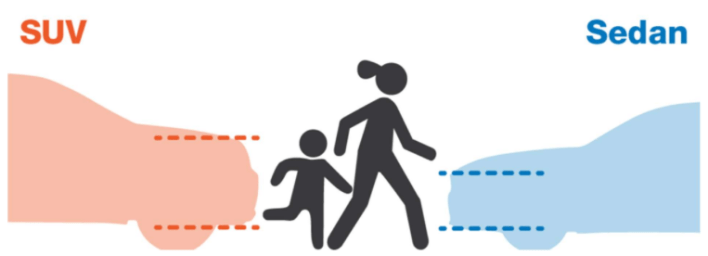
A raft of studies cited in the new report confirmed these intuitive facts with hard data, including one 2024 study of real-world crashes in the U.S. which estimated that a pedestrian is "70 percent more likely to die if the vehicle involved [in the crash] is a pickup truck rather than a car, and death is twice as likely if the vehicle is a large SUV rather than a car." And that's not even accounting for the fact that American SUVs are bigger than their counterparts in other countries.
2. Hood shape
Even if a car is fairly tall, pedestrians still tend to fare better in a crash if the hood is designed with a gentle slope that pushes a walker up onto the windshield — which will certainly hurt, but might not end her life. Too many American SUVs and trucks, though, are designed with flat, aggressive front-ends that push any walker to the ground, and vastly increases the chances that she'll suffer a second, unsurvivable impact when the vehicle rolls over her body.
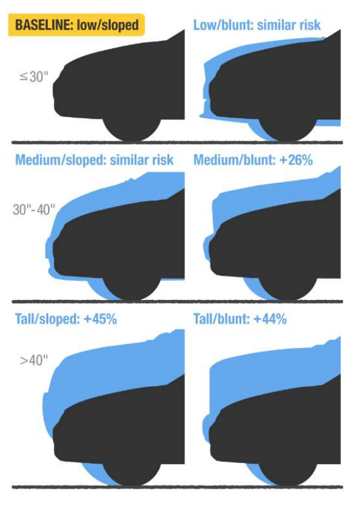
"SUVs, pickups, and vans are not simply scaled-up versions of sedans," the report authors wrote. "They have specific design features that can prove deadlier to occupants of other vehicles as well as vulnerable road users."
One study of nearly 18,000 crashes found that "even among vehicles with front ends between 30 and 40 inches high, those with blunt, more vertical profiles were 26 percent more likely to cause pedestrian fatalities than lower and more sloped vehicles."
Put another way: some automakers are taking inherently dangerous tall and heavy cars and make them even more dangerous with styling choices like flat front grilles — and they don't have to do it.
3. Huge blind zones
Needless to say, a super-tall car with a big, chunky hood is going to make it pretty hard for a motorist to see the road right in front of him — and not just for obvious reasons.
According to research cited in the new report, some of a megacar's biggest blind spots are located behind the "a-pillars," or the vertical pieces of plastic that flank the windshield, blocking a particularly large segment of the motorists' view when they're turning. As cars have gotten heavier and bigger, these pillars have also grown to support the weight of all that metal.
Increasingly large side mirrors have created new blind spots on big cars, too, especially when pedestrians and cyclists are traveling catty-corner to a vehicle — or, as tragically happens hundreds of times a year, when little kids are standing, sitting or crawling in front of their caregivers' cars, often in their very own driveways. The report noted that 75 percent of "frontover" crashes involve SUVs, vans, or trucks, and that children are disproportionately likely to be killed.
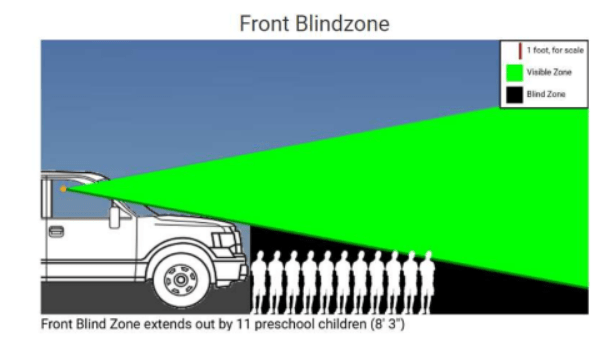
"Drivers cannot avoid what they cannot see, and while backup cameras have been required by law on all new cars since 2018, there is no required United States standard for forward vision from the driver’s seat," the report authors wrote. "This is in contrast with UN regulations in place for more than 50 countries. Only direct vision – a line of sight between the driver’s own eyes and other road users – allows for eye contact and communication between drivers and those outside the vehicle."
4. Crash incompatibility
Of course, vulnerable road users aren't the only ones who are unlikely to survive a crash with a big car. The researchers also found that the sheer mismatch between light trucks and every other vehicle on the road is contributing to our national road death numbers, despite both camps traveling in reinforced metal cages.
One analysis cited by the study found that "side-impact collisions frequently caused head and upper thorax injuries to the occupants of the smaller vehicle because of the high position of the light truck’s bumper." In head-on collisions, meanwhile, the big car was more likely to push the instrument panel or steering column into the body of the person behind the wheel of the smaller car, which was itself more likely to cause a grisly, unsurvivable head or neck injury.
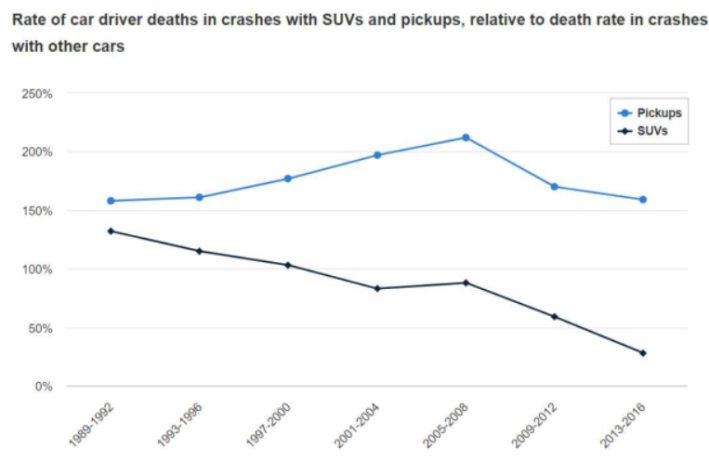
Fear of getting literally impaled on a steering column, of course, might be a pretty strong motivator for an American to buy a bigger car — even if it means endangering his neighbors who don't drive.
"With large differences in size or design features, the occupants of smaller, lighter vehicles may be at greater risk of injury or death, and may join the 'arms race' by buying a larger vehicle themselves — with all the negative externalities that greater light truck mode share brings to pedestrians and cyclists," the researchers wrote.
5. Frame stiffness
One emerging area of megacar research has to do with "frame stiffness," or how rigid the chassis is upon which the weight of car rests. A stiff frame, like most SUVs, pick ups, and EVs have, actually decreases the amount of energy a big vehicle will absorb in a crash — "meaning more damage will occur to whatever person or object the larger vehicle hits," the report authors explained.
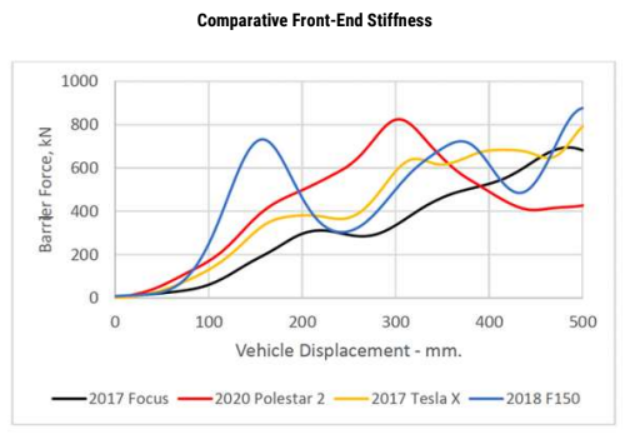
In one study cited in the report, for instance, researchers found that an electric Polestar 2 – a Swedish Volvo model which isn't even all that tall compared to America's most popular SUVs — will have about one foot (300 mm) of its front end crushed in a major crash. A non-electric Ford Focus, meanwhile will have 1.6 feet (500 mm) of its front end demolished in the same crash, increasing the chances that its occupants will be injured.
In slower crashes, though, even megacars' occupants may suffer, too.
"Furthermore, the advantage of the high stiffness may be protective for a vehicle’s own occupants in two-vehicle collisions, but it may not be protective in relatively more-frequent lower-velocity impacts with similar vehicles or fixed objects," the report authors wrote. "In these types of crashes, occupants will be exposed to higher inertial forces than in vehicles designed with less stiff front ends."
6. Drivers of huge cars are more likely to speed
Another less-talked about reason why light trucks are so deadly is how the design of the car itself incentivizes the other element of Newton's second law of motion besides mass: hot, nasty, badass speed.
In one study, for instance, researchers "showed a direct relationship between vehicle seat height and a skewed perception of speed among drivers," the report authors wrote. That was because the higher seating position (and, possibly, lack of road noise) actually effects the way the human brain perceives its own speed, with the average driver gunning it four miles per hour faster at the seating level of an SUV compared to that of a compact car.
Even worse: "Modeling indicates [SUV drivers in trials] may have perceived their speeds to be 10 mph slower at the higher seated position," and "only one-third of participants reported noticing they drove faster at a higher seating position."
The human brain isn't the only reason light truck drivers are going faster these days, either. The report authors pointed out that "between 1975 and 2021, average horsepower of new vehicles increased by 85 percent," and other researchers found that "drivers of high-horsepower vehicles are more likely to exceed the speed limit, particularly by 10 mph or more, compared with drivers of less-powerful vehicles."
They also note that acceleration has increased by leaps and bounds, too, especially among heavy EVs like the electric Hummer, which "now has the ability to accelerate from 0 to 60 mph in about three seconds, rivaling the acceleration capabilities of some Formula 1 race cars."
"There is no practical need for this level of ultra-fast acceleration in everyday vehicle use," the authors wrote. "And the large battery it requires in already-heavy EVs means greater weight, longer stopping time, and greater force exerted in a crash."
